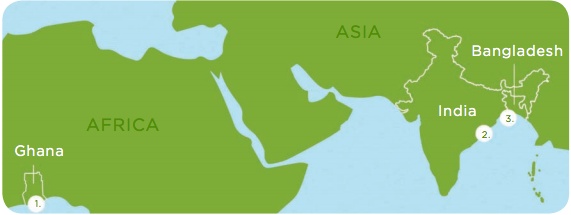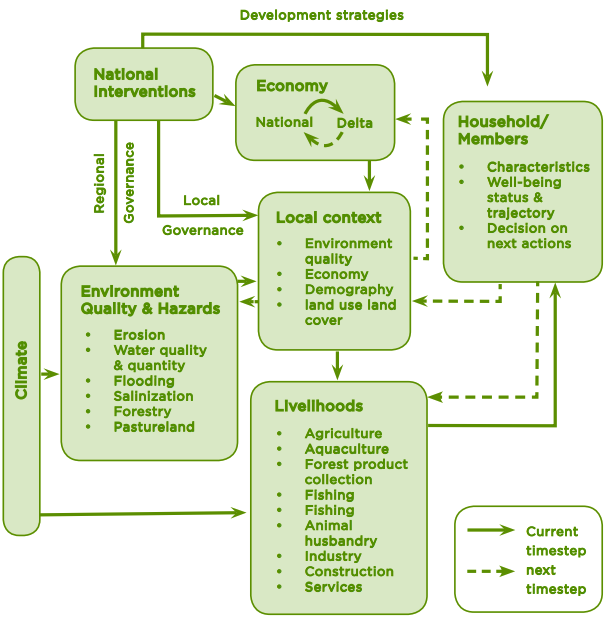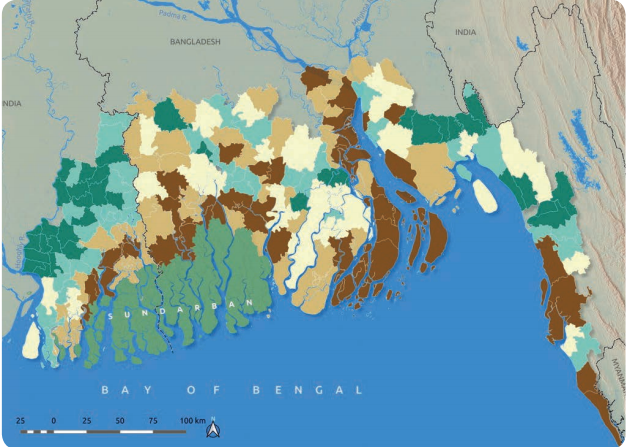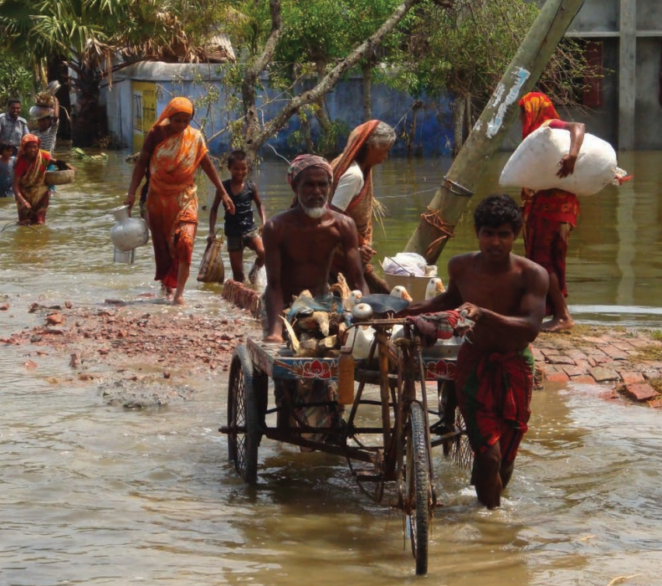Climate change, migration and adaptation in deltas: Key findings from the DECCMA project

Introduction
Deltas are home to 500 million people worldwide and known as a climate change “hotspot” – a place where high exposure to climate stresses coincides with high levels of vulnerability. Deltas are also significant contributors to national economies. In Bangladesh, India and Ghana they supply, and sometimes add value to, natural resources such as agriculture and fishing, which comprise 16-29% of the GDP in the deltas.
The Deltas, Vulnerability and Climate Change: Migration and Adaptation(DECCMA) project has applied multiple methods to investigate the present and future situation of climate and environmental change, migration and adaptation in three delta systems: the transboundary Ganges-Brahmaputra-Meghna megadelta (comprising the Indian Bengal delta, as well as the bulk in Bangladesh), the Mahanadi delta in India, and the Volta in Ghana.
This report* summarises the key approaches, methods, findings and achievements of the DECCMA project. DECCMA ran from 2014-2018 and is part of the IDRC and DFID funded CARIAA programme.
*Find summaries of key sections of the paper below. Download the full text from the right-hand column for more detailed information. See the full text for numerous further resources.

Approach
For each delta investigated the DECCMA project undertook the following activities – the methods used to achieve these actions are outlined in detail in the report:
- Risk mapping based on the IPCC framework (hazard, sensitivity, vulnerability, adaptive capacity)
- Analysed how environmental shocks and change affects economic output, employment and linkages, using macro-economic models and scenarios (see the integrated model below)
- Investigated adaptation strategies and migration behaviour across the deltas through surveys of women and men in more than 5000 households in areas from low to high exposure to natural hazards
- Investigated the multiple dimensions of well-being and the lived experience of migrants in cities of the deltas through surveys of more than 2500 migrants in seven destination cities and towns
- Compiled inventories of documented adaptation
- Reviews of governance and policy
- Developed a Computable General Equilibrium (CGE) model (DeltaCGE) based on custom Social Accounting Matrix and Input-Output tables to investigate delta economies under different climate scenarios and adaptation policy directions [see pages 10-11]
- Developed a conceptual model to investigate plausible future household migration and adaptation patterns
This common approach allowed the team to compare across deltas.

Key findings
On the present situation in deltas:
Deltas are at risk from climate change – sea level rise, coastal erosion, flooding, salinization. In the Ganges Brahmaputra Meghna delta in Bangladesh and India efforts to address poverty, generate non-farm employment or improve health and sanitation status have played a role in reducing social vulnerability. However, major cyclones such as Sidr (2007) and Aila (2009) and other climatic hazards have increased social vulnerability in some subdistricts.
Deltas play a key role in national economies.They supply, and sometimes add value to, natural resources such as agriculture and fishing, which comprise 16-29% of the GDP in the deltas.
Migration from rural areas to nearby urban areas is a continuing trend, driven largely by economic opportunity. Migration patterns are also strongly gendered. The majority of migrants are men, and in all three countries over three quarters of migrants move within their own countries.
Migration has consequences in both sending and receiving areas. Implications depend on whether migration is voluntary or involuntary. Involuntary migration can contribute to urban centres becoming crucibles of risk, with poverty in terms of material status and perceived well-being.
Environment is a proximate cause of migration. Less than 3% of respondents singled out an environmental cause as the main reason for their migration. However, one third of all households with migrants perceived that there was an increased exposure to environmental hazards, and 40-80% of the respondents across the four deltas associated environmental factors with more insecure livelihoods.
Displacement and planned relocation are already occurring. After watching land and houses in Satavaya Gram Panchayat fall into the sea, the state government of Odisha has taken a pioneering and “humanitarian approach” to relocation (see page 24).
Adaptation is occurring now and comprises structural and livelihood adaptations, and migration. The most used actions include the use of loans, changing the amount of fertiliser used on the farm, and planting trees around the home. Migration was used as an adaptation response in all three deltas, but was not among the top three strategies deemed to be successful adaptations in any of the deltas.
There is a sub-optimal policy and implementation framework for migration and adaptation. Governments seem averse to recognising migration and many countries have a “policy gap”. The lack of customary legal frameworks may discourage people from moving because they fear the loss of their land.
Lessons learned on resettlement in India:
The experience of resettlement from Satavaya to Bagapatia highlights three lessons for the future. The first is the need for provision in resettlement and rehabilitation legislation and policies for people displaced by environmental factors. The second is that livelihood provision and support should take place concurrently with provision of homestead land and housing. The third is that a single nodal agency – or task team – from the beginning may facilitate coordination and expedite an effective and efficient process.
On the future situation in deltas:
Impacts of 1.5C temperature increase will lead to increased flooding in Bangladesh. A global average temperature increase of 2oC (which is likely to occur before 2033) will bring with it an increase in sea level of between 5-14cm. If the temperature increase reaches 3oC, some of the consequences more than double.
Climate change will lead to significant economic losses by 2050. In the Mahanadi the main shocks are found in infrastructure, accounting for 11% cumulative loss in GDP per capita, or 0.25% GDP per capita in the whole of India. In the Volta the effects on fisheries are relatively more important, whilst in the Ganges Brahmaputra-Meghna agriculture is the sector with the biggest economic impacts, accounting for 10% cumulative loss in GDP per capita, or 2% GDP per capita reductions in the rest of the country.
More adaptation will be needed, and we have modelled the influential drivers of adaptation decisions by male- and female-headed households. Adaptation can effectively reduce the magnitude of projected impacts. For agriculture, embankments and protection and restoration of mangroves could reduce projected economic losses by about 2% in the Indian deltas. In the Volta delta, the effects from the expected shocks on fisheries could be reduced by housing for fisheries, establishment of fish seed hatcheries, and further development of retail fish markets and allied infrastructure.

Engagement and Impacts
Key results of DECCMA’s engagement and impacts are given below. See the full report for details of how these were achieved (download from the right-hand column).
Policy impacts achieved by DECCMA include:
- Raising the profile of delta residents with parliamentarians (Volta)
- Inputs to the Coastal Development Authority Bill (Volta)
- Requested to provide inputs to policy and highlighting delta migration (Mahanadi)
- Partnership with the West Bengal State Department of Environment (Indian Bengal delta)
Capacity building impacts achieved by DECCMA
Building the capacity of early career researchers has been a priority for DECCMA. Throughout the lifetime of the project, 16 men and 17 women have undertaken postgraduate studies for Masters or Doctoral degrees as part of the project, and many more have gained experience as research assistants. Specialist training has been run under several themes, from land cover mapping (by FAO), to input-output economics (by the BC3 Basque Centre for Climate Change), and the development of Bayesian network models and integrated assessment models (by the University of Southampton). Exchange and field visits have also taken place among all the research teams.

This work was carried out under the Collaborative Adaptation Research Initiative in Africa and Asia (CARIAA), with financial support from the UK Government’s Department For International Development (DFID) and the International Development Research Centre (IDRC), Canada.
- Website: www.deccma.com
- Twitter: @DECCMA
(0) Comments
There is no content